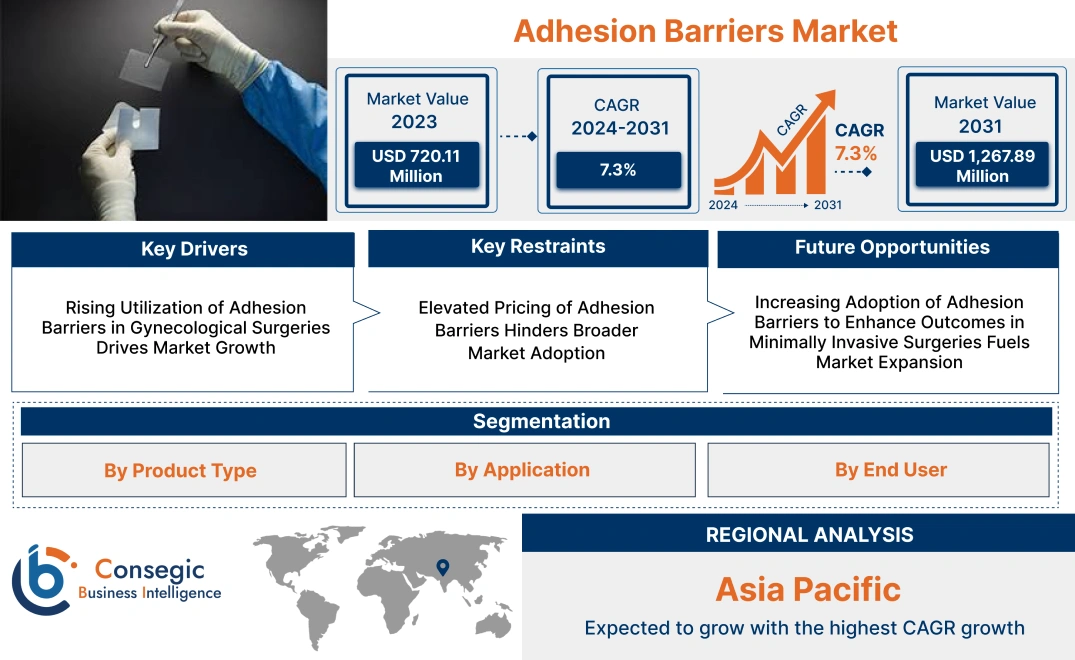- Summary
- Table Of Content
- Methodology
Adhesion Barrier Market Size:
Adhesion Barrier Market size is estimated to reach over USD 1,267.89 Million by 2031 from a value of USD 720.11 Million in 2023 and is projected to grow by USD 760.05 Million in 2024, growing at a CAGR of 7.3% from 2024 to 2031.
Adhesion Barrier Market Scope & Overview:
Adhesion barriers are specialized medical devices designed to prevent the formation of fibrous bands, known as adhesions, between tissues and organs after surgery. These barriers are typically made from biocompatible, biodegradable materials, including films, gels, and liquids, that serve as a temporary physical barrier to reduce tissue attachment during the healing process. Key features include non-toxicity, adaptability to various surgical sites, and controlled degradation within the body. Benefits include minimizing postoperative complications, reducing pain, and lowering the risk of additional surgeries. Adhesion barriers are widely applied in abdominal, gynecological, cardiovascular, and orthopedic surgeries, with primary end-users being hospitals, ambulatory surgical centers, and specialty clinics.
Adhesion Barrier Market Dynamics - (DRO) :
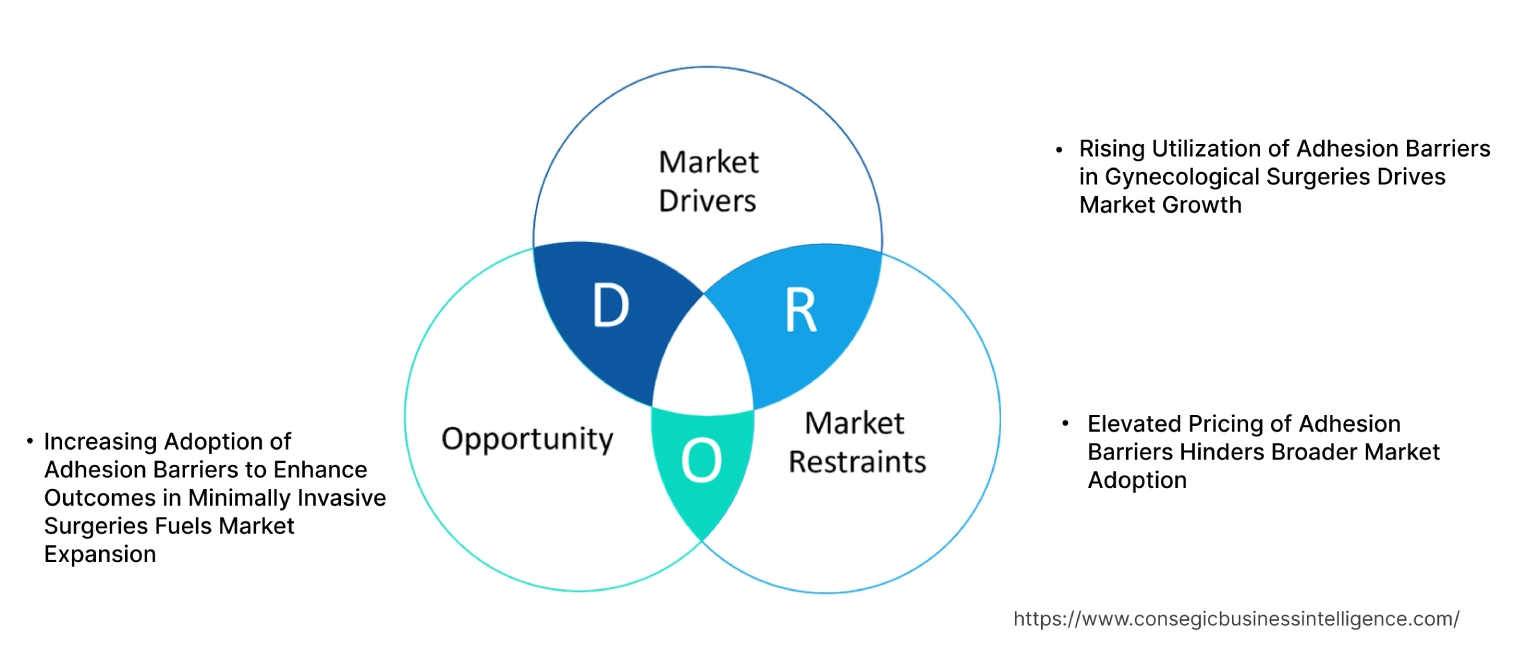
Key Drivers:
Rising Utilization of Adhesion Barriers in Gynecological Surgeries Drives Market Growth
The rising adoption of adhesion barrier in gynecological surgeries is significantly driving adhesion barrier market growth. In gynecological procedures, such as C-sections and hysterectomies, the risk of developing adhesions is particularly high due to the delicate nature of the reproductive organs and tissue trauma during surgery. Adhesion barriers, including films and gels, are increasingly used to create a physical separation between tissues, preventing postoperative adhesion formation, which can lead to complications like chronic pelvic pain, infertility, and bowel obstruction. The use of adhesion barrier enhances surgical outcomes, reducing the need for subsequent surgeries and improving patient recovery rates. For instance, a study published in 2023 highlighted a 30% reduction in postoperative complications in patients treated with adhesion barrier during gynecological surgeries. This growing utilization in specific surgical applications underscores the product's importance in enhancing procedural success and patient well-being, propelling the adhesion barrier to market demand in the healthcare sector.
Key Restraints :
Elevated Pricing of Adhesion Barriers Hinders Broader Market Adoption
The high cost of adhesion barrier is a key restraint affecting market growth. These barriers, made from specialized biodegradable and biocompatible materials, involve complex manufacturing processes, which increase production costs. Hospitals and surgical centers, particularly in developing regions, often face budget constraints that limit the adoption of expensive medical products, including adhesion barrier. Despite their clinical benefits in reducing postoperative complications, the high upfront costs can be prohibitive, especially for routine surgeries where cost-effectiveness is a primary consideration. Additionally, the lack of comprehensive insurance coverage for adhesion barrier products in several regions exacerbates this challenge, hindering broader market penetration.
Future Opportunities :
Increasing Adoption of Adhesion Barriers to Enhance Outcomes in Minimally Invasive Surgeries Fuels Market Expansion
The increasing prevalence of minimally invasive surgeries presents a significant growth for the adhesion barrier market opportunity. Minimally invasive procedures, favored for their reduced recovery time and lower risk of complications, still carry the risk of postoperative adhesions, which can compromise patient outcomes. Adhesion barriers, particularly gel and liquid formulations, are well-suited for minimally invasive applications due to their ease of application and ability to conform to complex tissue structures. The growing trend of laparoscopic and robotic surgeries in specialties such as gastrointestinal and gynecological procedures is set to boost the need for advanced adhesion barrier market share, creating new growth opportunities for the market.
Adhesion Barrier Market Segmental Analysis :
By Product Type:
Based on product type, the market is segmented into Film Adhesion Barriers, Gel Adhesion Barriers, and Liquid Adhesion Barriers.
Film Adhesion Barriers Accounted for the Largest Revenue Share of 53.52% in 2023.
- Film adhesion barrier are the most widely used type due to their proven efficacy and ease of application in various surgical settings.
- These products are designed as thin, flexible sheets made from biodegradable materials like hyaluronic acid, collagen, polylactic acid, and cellulose derivatives.
- Film barriers are typically applied during open surgeries, such as abdominal or pelvic procedures, where they create a physical barrier between tissues to prevent postoperative adhesions.
- One key advantage of film adhesion barrier is their mechanical stability, which ensures they remain in place during the initial stages of wound healing, offering effective separation of tissues.
- Additionally, film barriers are versatile and can be tailored to fit different anatomical sites, enhancing their adoption in various surgical specialties, including gynecology, colorectal, and general surgery.
- The dominance of this segment is further supported by the high incidence of surgeries requiring adhesion prevention, increasing the demand for reliable and efficient solutions like film adhesion barrier.
Gel Adhesion Barriers Are Anticipated to Register the Fastest CAGR During the Forecast Period.
- Gel adhesion barrier are projected to grow at the fastest pace, driven by their superior adaptability and broad range of applications, particularly in minimally invasive and laparoscopic surgeries.
- Gel barriers are formulated from bioresorbable polymers, including polyethylene glycol, polyvinyl alcohol, and chitosan, which form a viscous, transparent gel that conforms to irregular tissue surfaces.
- This characteristic makes gel adhesion barrier highly effective in procedures involving complex anatomical structures, where traditional film barriers may be challenging to apply.
- The rising popularity of minimally invasive surgeries, including laparoscopic and robotic-assisted procedures, has significantly boosted the demand for gel barriers, as they can be applied precisely through small incisions using applicators or syringes.
- Furthermore, gel barriers do not require additional fixation methods, reducing the risk of surgical complications and enhancing patient outcomes.
- Innovations in gel formulations, offering longer barrier duration and improved bioresorbability, are expected to further drive the adoption of gel adhesion barrier, making this segment the fastest-growing during the forecast period.
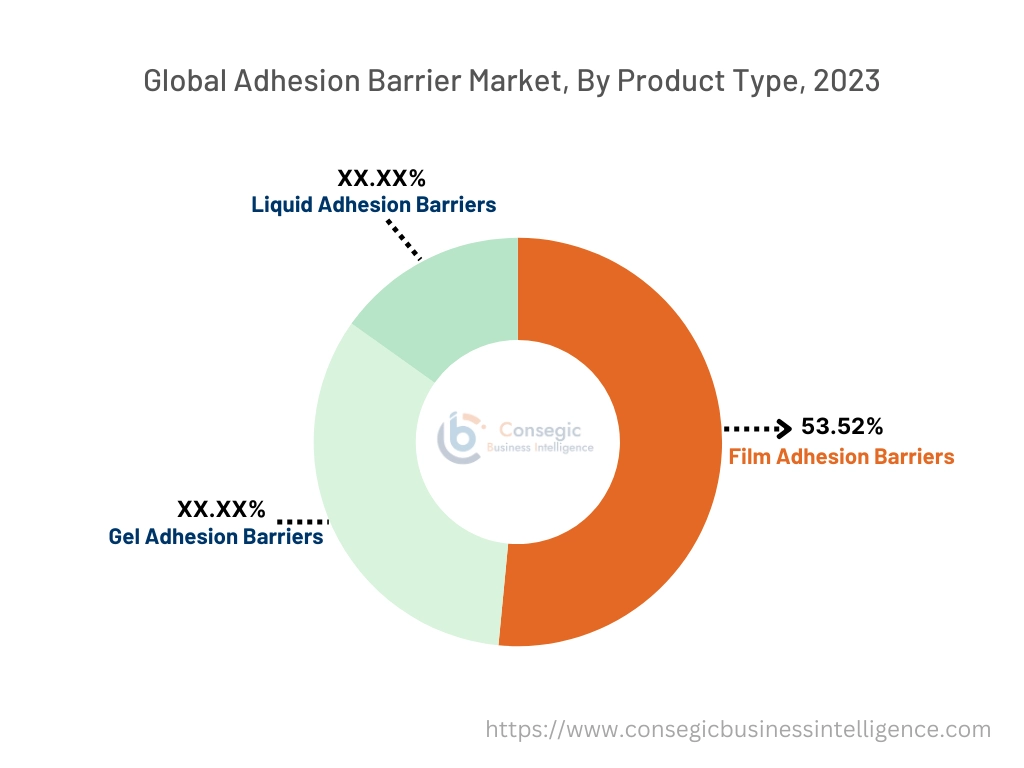
By Application:
The market is categorized based on application into Abdominal Surgeries, Gynecological Surgeries, Cardiovascular Surgeries, Orthopedic Surgeries, and Others.
Gynecological Surgeries Held the Largest Revenue Adhesion Barrier Market Share in 2023.
- Gynecological surgeries have emerged as the leading application segment for adhesion barrier due to the high risk of adhesion formation in procedures like hysterectomies, myomectomies, and cesarean sections.
- Postoperative adhesions in gynecological surgeries can lead to severe complications, including chronic pelvic pain, infertility, and bowel obstruction, making the use of adhesion barrier crucial for improving surgical outcomes.
- Film and gel adhesion barrier are commonly employed in these procedures, providing effective separation of tissues and reducing the risk of adhesion formation.
- The increasing number of gynecological surgeries, driven by the rising prevalence of conditions like endometriosis, fibroids, and pelvic inflammatory disease, has significantly contributed to the strong revenue share of this segment.
- Hospitals and specialty clinics performing these procedures frequently adopt adhesion barrier as part of their standard surgical protocols, aiming to enhance patient recovery and minimize the need for follow-up surgeries.
Orthopedic Surgeries Are Expected to Register the Fastest CAGR during the Forecast Period.
- The use of adhesion barrier in orthopedic surgeries is anticipated to grow rapidly due to the increasing number of procedures like joint replacements, spinal surgeries, and trauma-related operations.
- Adhesions in orthopedic surgeries can lead to complications such as limited joint mobility, chronic pain, and nerve compression, making the prevention of tissue adherence a critical aspect of postoperative care.
- Gel and liquid adhesion barrier are often preferred in these cases due to their flexibility and ability to conform to irregular bone and tissue surfaces.
- The rising adoption of advanced surgical techniques, including minimally invasive and robotic-assisted orthopedic procedures, has further propelled the adhesion barrier market demand for, as these products help in reducing complications and improving long-term patient outcomes.
- Additionally, the growing aging population, which is more prone to bone and joint disorders, is expected to drive the number of orthopedic surgeries, thereby fueling the demand for adhesion barrier in this segment.
By End-User:
The end-user segment of the market is divided into Hospitals, Ambulatory Surgical Centers (ASCs), Specialty Clinics, and Research Institutes & Academic Centers.
The hospitals segment accounted for the Largest Revenue adhesion barrier market Share in 2023.
- Hospitals are the leading end-users of adhesion barrier due to the high volume and variety of surgeries performed in these facilities.
- They serve as the primary point of care for complex surgical procedures, including abdominal, gynecological, cardiovascular, and orthopedic surgeries, where the risk of adhesion formation is significant.
- Hospitals often possess advanced surgical infrastructure and have access to a broad range of medical products, enabling the effective utilization of adhesion barrier.
- The use of adhesion barrier in hospitals has become a standard practice to enhance surgical outcomes, reduce postoperative complications, and minimize hospital readmissions.
- Additionally, hospitals benefit from the availability of specialized surgical departments, which increases the adoption of adhesion barrier across multiple specialties.
- The adhesion barrier market demand in hospitals is further supported by the rising number of surgeries driven by aging populations, increasing prevalence of chronic diseases, and advancements in surgical techniques.
Ambulatory Surgical Centers (ASCs) Are Expected to Register the Fastest CAGR during the Forecast Period.
- ASCs are projected to witness the fastest growth in the adoption of adhesion barrier, driven by the increasing adhesion barrier market trend toward outpatient and minimally invasive surgeries.
- ASCs offer a convenient and cost-effective alternative to hospitals, focusing on same-day surgical procedures with reduced recovery times.
- These centers are particularly well-suited for elective surgeries, including laparoscopic, orthopedic, and gynecological procedures, where the use of adhesion barrier is crucial to prevent postoperative complications.
- The streamlined operations and lower costs of ASCs make them an attractive option for patients and surgeons, contributing to the rising number of procedures performed in these facilities.
- The adoption of adhesion barrier in ASCs is further propelled by the growing preference for minimally invasive techniques, which often require products like gel and liquid adhesion barrier due to their ease of application and adaptability to irregular tissue surfaces.
- The expansion of ASCs, particularly in developed regions with advanced healthcare infrastructure, is expected to drive significant growth in this segment.
Regional Analysis:
The regions covered are North America, Europe, Asia Pacific, the Middle East and Africa, and Latin America.
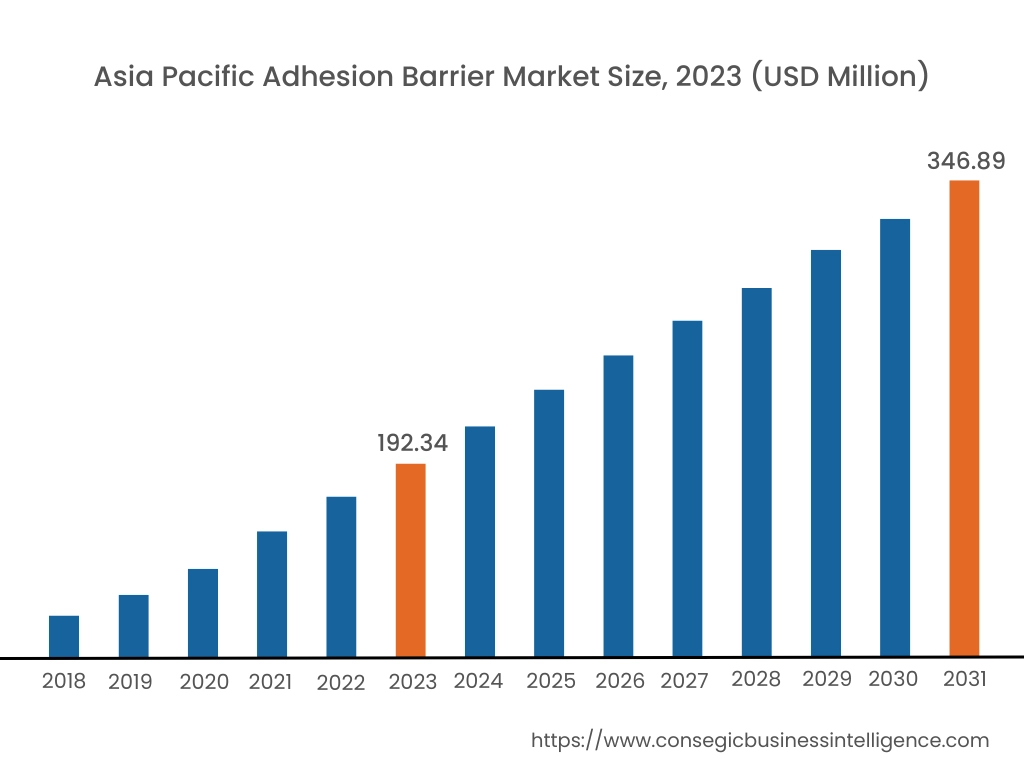
Asia-Pacific is estimated to reach over USD 346.89 Million by 2031 from a value of USD 192.34 Million in 2023 and is projected to grow by USD 203.41 Million in 2024. Out of which China accounted for the largest share of 28.2%. Asia-Pacific is expected to register the fastest growth due to the rising number of surgeries, increasing healthcare expenditure, and growing adoption of minimally invasive procedures in countries like China, India, and Japan. The region's expanding medical tourism industry and the rising prevalence of chronic diseases further boost the demand for adhesion barrier.
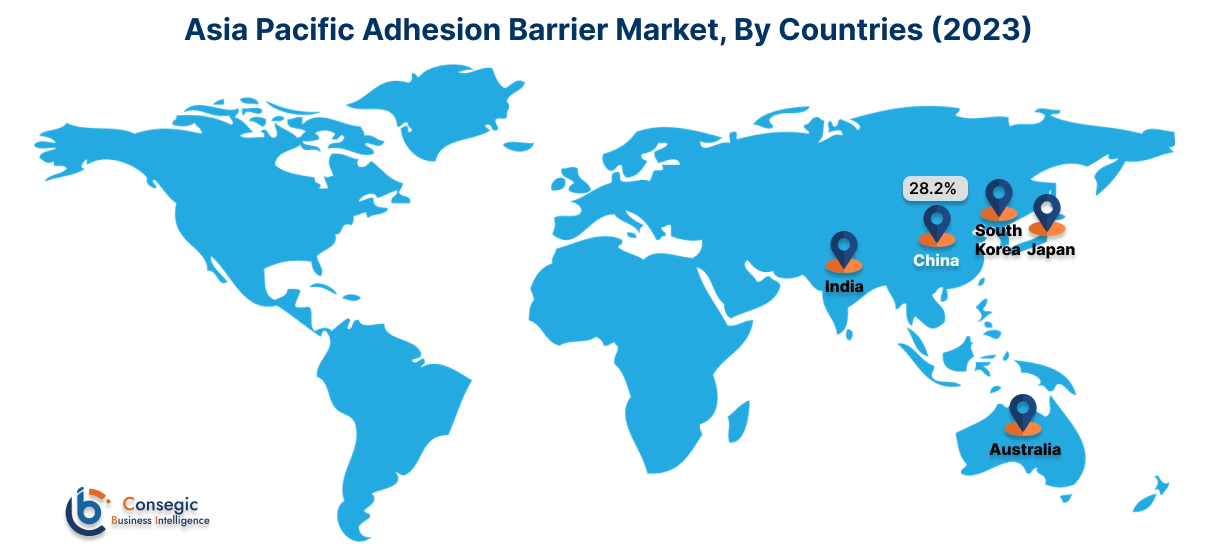
North America is estimated to reach over USD 416.76 Million by 2031 from a value of USD 233.33 Million in 2023 and is projected to grow by USD 246.57 Million in 2024. The adhesion barrier market share exhibits distinct trends across different regions. North America dominates the market, driven by the high volume of surgical procedures and the presence of advanced healthcare infrastructure. The increasing prevalence of abdominal and gynecological surgeries, coupled with strong regulatory support and widespread adoption of advanced surgical products, bolsters adhesion barrier market growth in the region.
Europe is the second-largest market, supported by rising awareness of postoperative complications and the increasing adoption of adhesion barrier, especially in countries like Germany, France, and the United Kingdom. The region's focus on reducing healthcare costs and improving surgical outcomes also contributes to market expansion.
In the Middle East and Africa, the market is driven by the improving healthcare infrastructure and growing awareness of adhesion prevention, particularly in the UAE and South Africa. Latin America shows moderate adhesion barrier market growth, with increasing adoption of adhesion barrier in countries like Brazil and Mexico, where the demand is driven by the rising number of gynecological and abdominal surgeries, along with government initiatives aimed at improving healthcare outcomes. This comprehensive regional analysis highlights specific adhesion barrier market trends and factors influencing the market dynamics across these key regions.
Top Key Players & Market Share Insights:
The Global Adhesion Barrier Market is highly competitive with major players providing FWA to the national and international markets. Key players are adopting several strategies in research and development (R&D), product innovation, and end-user launches to hold a strong position in the Adhesion Barrier Market. Key players in the Adhesion Barrier industry include -
- Baxter International Inc.-(US)
- Johnson & Johnson Private Limited – (US)
- Becton, Dickinson, and Company (BD) – (US)
- Integra LifeSciences Corporation – (US)
- Anika Therapeutics, Inc. – (US)
- FzioMed, Inc. – (US)
- MAST Biosurgery USA, Inc. – (US)
- Getinge AB – (Europe)
- Innocoll Holdings PLC – (Europe)
- Terumo Corporation – (Europe)
Recent Industry Developments :
Approvals:
- In February 2022, Gunze Limited received medical device approval for TENALEAF, an absorbable adhesion barrier blade, marking a significant addition to its product portfolio.
Adhesion Barrier Market Report Insights :
| Report Attributes | Report Details |
| Study Timeline | 2018-2031 |
| Market Size in 2031 | USD 1,267.89 Million |
| CAGR (2024-2031) | 7.3% |
| By Product Type |
|
| By Application |
|
| By End-user |
|
| By Region |
|
| Key Players |
|
| North America | U.S. Canada Mexico |
| Europe | U.K. Germany France Spain Italy Russia Benelux Rest of Europe |
| APAC | China South Korea Japan India Australia ASEAN Rest of Asia-Pacific |
| Middle East and Africa | GCC Turkey South Africa Rest of MEA |
| LATAM | Brazil Argentina Chile Rest of LATAM |
| Report Coverage |
|
Key Questions Answered in the Report
What is an adhesion barrier? +
Adhesion barriers are medical devices designed to prevent the formation of fibrous adhesions between tissues after surgery.
What are the key types of adhesion barrier? +
The main types include film, gel, and liquid adhesion barrier, each designed for specific surgical applications.
Which surgeries commonly use adhesion barrier? +
Adhesion barriers are widely used in abdominal, gynecological, cardiovascular, and orthopedic surgeries.
What drives the demand for adhesion barrier? +
Rising surgical procedures and increasing awareness of postoperative complications drive the demand for adhesion barrier.
Which region leads the adhesion barrier market? +
North America holds the largest market share due to advanced healthcare infrastructure and a high number of surgical procedures.
